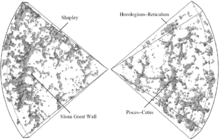2dF Galaxy Redshift Survey
 |
|
| Alternative names | 2dF |
|---|---|
| Survey type |
Astronomical survey |
| Observations |
Anglo-Australian Telescope |
| Website | www |
|
[]
|
|
In astronomy, the 2dF Galaxy Redshift Survey (Two-degree-Field Galaxy Redshift Survey), 2dF or 2dFGRS is a redshift survey conducted by the Anglo-Australian Observatory (AAO) with the 3.9m Anglo-Australian Telescope between 1997 and 11 April 2002. The data from this survey were made public on 30 June 2003. The survey determined the large-scale structure in two large slices of the Universe to a depth of around 2.5 billion light years (redshift ~ 0.2). It was the world's largest redshift survey between 1998 (overtaking Las Campanas Redshift Survey) and 2003 (overtaken by the Sloan Digital Sky Survey). Matthew Colless, Steve Maddox and John Peacock were in charge of the project. Team members Shaun Cole and John Peacock were awarded a share of the 2014 Shaw Prize in astronomy for results from the 2dFGRS.
The 2dF survey covered an area of about 1500 square degrees, surveying regions in both the north and the south galactic poles. The name derives from the fact that the survey instrument has a 2 degree diameter field of view.
The areas selected for observation were previously surveyed by the massive APM Galaxy Survey (on which Steve Maddox also worked). The regions surveyed cover roughly 75 degrees of right ascension for both bands, and the declination of the North Polar band was about 7.5 degrees while the declination of the South Polar band was about 15 degrees. Hundreds of isolated two degree fields near the South Polar band were also surveyed (see this illustration, where black circles represent survey fields, and the red grid represents the earlier APM survey).
In total, the photometry of 382,323 objects were measured, which includes spectra for 245,591 objects, of which 232,155 were galaxies (221,414 with good quality spectra), 12,311 are stars, and 125 are quasi-stellar objects (quasars). The survey necessitated 272 required nights of observation, spread over 5 years.
...
Wikipedia
